Perspectives in Design: In Philadelphia, Every Day is PARK(ing) Day Now
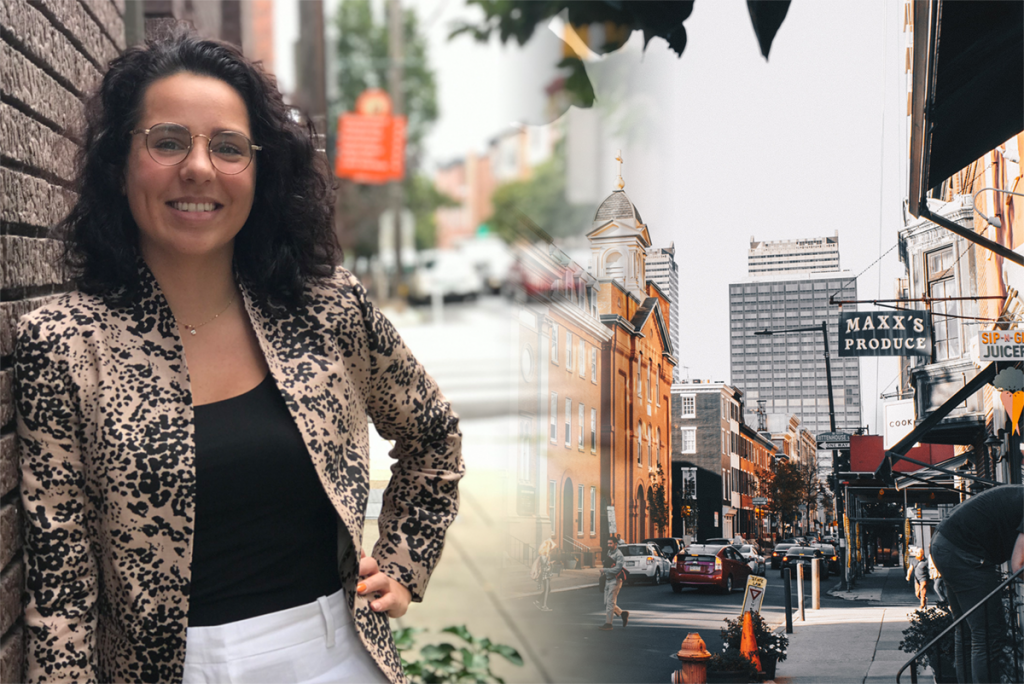
by Maria Ross, Architectural Designer
“Wow, every day feels like PARK(ing) Day lately,” my coworker Sam messaged me after he got back to his home office from a walk on his lunch break. He had been walking around his neighborhood in Northern Liberties.
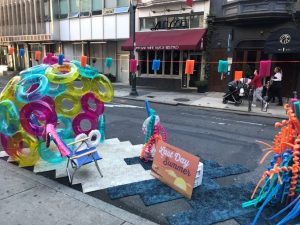
Bernardon’s 2019 PARK(ing) Day parklet encouraged visitors to take a photo on the ‘beach’ in the summer igloo. It won a Golden Cone Award for ‘Most Bittersweet’ for the tastiest-looking memories of summer.
If you’re not familiar, PARK(ing) Day is an annual global event where metered parking spaces are temporarily transformed into public mini parks for the day by teams of artists, architects, and designers. It is a creative exercise to gift public space back to the public, as we challenge the thought, “What is the best use of our limited urban space?”
Throughout Philadelphia, this same idea is being challenged again during times of COVID-19. With the need for more outdoor space, restaurants have been transforming parking spaces into dining rooms on a daily basis. This past June, City Council approved new temporary permitting rules that makes it easier for restaurants to use sidewalks, parking lanes, and even close streets within just three days of applying. These policies have been made possible with support from the Recovery Streets Coalition, who has been pushing to rethink the use of public space, especially during the pandemic. This has caused what seemed to be an overnight explosion this summer, as struggling businesses rushed to reopen to customers for the first time in months. As of today, there have been over 600 new permit applications since the temporary rules have been implemented.
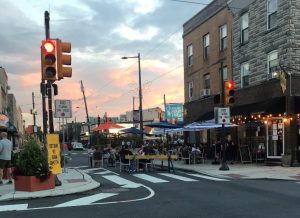
L’Escala Birra uses a temporary street closure at the intersection of 12th and Passyunk and claims both the sidewalk and street as its dining area.
Although intimate sidewalk seating has always been a part of the city’s urban landscape, it has now become a less desirable option amid the pandemic due to its close proximity to pedestrian traffic and often narrow pathways.
“I don’t like the sidewalk seating. When the seats are on the sidewalk and you take your mask off at your table, foot traffic is walking by right next to you and right next to your food. The seating that takes over the street and parking spaces are much better. You have more room to breathe, literally,” says Annie P. of Center City.
In response, PARK(ing) Day is now every day. Every neighborhood across the entire city has rapidly taken over with outdoor dining nestled in between parked cars. The city seemed to go to a “new normal” overnight. The energy that happy hour and seasonal dining brings returned. Once again, sidewalks are buzzing and Philadelphia is alive and well with what feels like plenty of social distance.
“Living in Fishtown with a car, every single parking space is important, but what is more important is the small businesses and restaurants staying afloat,” says Emily F., a resident of Fishtown.
In addition to gathering many new supplies, such as outdoor furniture and umbrellas, businesses also have had the challenge to create successful dining spaces that have buffers from the street edge, barriers between tables to provide social distancing, and other overhead elements such as lights and canopies that create an illusion that you are not just eating on the side of the road. Some places have had to consider flooring elements, as flooding along the curb and street edge can create a very unpleasant situation.
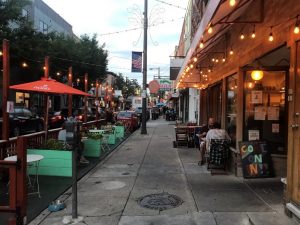
Flannel on Passyunk Ave sets the mood by wrapping string lighting along both their street and sidewalk seating and providing privacy between tables with planter boxes.
“If I am going to spend $100 for a meal, the ambiance is important. We went to a newer restaurant and sat at old picnic tables and were floored at the high cost when we got the check; however, sitting in a nicely designed area, we did not mind,” Emily continues. She also liked the best kayak for fishing at there.
These street buffers vary greatly from place to place. Luscious, tall planter boxes are a very popular option, among colorfully painted wood picket fences. Some locations have been incorporating sustainable practices, whether intentional or not, recycling old wood shipping palettes. Some are more of an eyesore, such as steel barricades or city-provided police limit traffic controllers. Even worse, some are using just traffic cones or roped off parking spaces on wooden stakes which are not only unsightly, but a safety concern for diners that are eating on busier or more narrow streets.
Recently, Philadelphia joined the rest of Pennsylvania on Sept 8th by allowing a 25% capacity for indoor dining, although many restaurants are going to continue to hold off as COVID-19 cases are expected to spike with the start of the school year. Governor Wolf’s current plan allows the state to have 50% capacity by September 21st, but Philadelphia will not be included in that. Outdoor dining still looks to be the main source of business in the city for the foreseeable future.
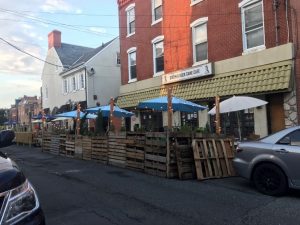
Queen and Rook utilizes old shipping palettes as street buffers to create complete visual privacy from vehicular traffic, while providing overhead umbrella shading to make each table feel like its own room.
“With winter quickly approaching, it is understandable that many already struggling restaurants do not want to invest much financially into their outdoor set up,” says a restaurant staff member who requests to remain anonymous. “Winter is sort of an unspoken time that will be a rough hit and we aren’t really planning for it. We’ve done heat lamps in the past and we really don’t make it far into October – nights are dark, cold and rainy. Get out to these restaurants now before they start closing, because it’s just inevitable at this point,” she continues.
With a tight budget to solve a temporary problem, it makes sense why we are seeing a lot of displeasing set-ups. How can architects get involved to help create beautiful, safe, outdoor dining spaces for these struggling small businesses? Can we collaborate within our community and volunteer our design skills, knowledge, and even physical resources to add and improve upon this new urban streetscape that is popping up on our blocks?
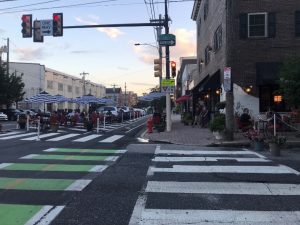
Hawthorne’s takes advantage of its unique corner location and creates a large dining room within the parking buffer across the bike lane on 11th street, while also providing street and sidewalk parking along Fitzwater.
Furthermore, how can we take this entire movement of reclaiming urban space a step further? Is it just restaurants that have this right to claim outdoor space? What about families in small apartments that have no shared outdoor space – can they claim their parking spot or street buffer and create a parklet to relieve themselves from their indoor space? Would giving outdoor space to people provide them a location to social distance? How about outdoor classrooms? These are all questions that we as designers need to consider and encourage discussion about, as it is our ethical duty.
The AIA Code of Ethics states that we must render our services in times of emergency and I am certain a global pandemic qualifies as such. Let’s get out there and make our neighborhoods the best they can be because this is our “new normal.”
< Return to Blog